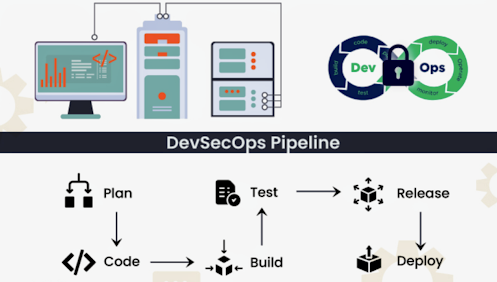Introducing DevSecOps: Integrating Security into Software Development
DevSecOps is an approach that integrates development, security, and operations practices. Like DevOps or SecOps, it is a concept that combines two previously separate roles into a single environment. The DevSecOps team is responsible for ensuring that secure software is continuously developed.
DevSecOps, a concept newer than DevOps, was created to emphasize the importance of IT security processes and security automation in the software development lifecycle. While the idea of integrating development and IT operations teams isn’t new, until recently, security policy was often considered the responsibility of the security team alone.However, as concerns about cybersecurity have grown, it has become clear that security controls are a key aspect of continuous delivery and should be the responsibility of everyone, not just a dedicated security team.
Fundamental tenets of DevSecOps principles (in contrast to conventional DevOps principles)
- Information security practices should be an integral part of the software development life cycle and should be applied to all phases of the workflow.
- Security should be shared by all team members involved in the software development process, not just the security experts.
- Security issues should be discovered as early as possible in the development cycle.
- Security threat scanning should be automated as much as possible to ensure development flexibility.
History of DevOps and DevSecOps
The traditional waterfall model of software development involved lengthy analysis, design, and development phases, followed by manual testing and release. With the advent of agile methodologies, software development now involves regular small changes and frequent releases. This has made manual software delivery impossible, and automation has become necessary. DevOps emerged to streamline and automate software delivery, with a DevOps team using continuous integration / continuous delivery (CI/CD) solutions to create development pipelines. However, the original concept of DevOps did not include security, leaving security teams to manually check for potential vulnerabilities after the application was released.
This approach was inflexible and slowed down the development process. This led to DevSecOps, which integrates security initiatives at every stage of the software development lifecycle, making security an integral part of the process. Security extension on the left side of the SDLC diagram.
A Healthy DevSecOps Operating Model

In the DevSecOps model, security is integrated into all phases of the software development life cycle, from planning to deployment. Let’s take a closer look at each step and the tools and methods used to ensure security are an integral part of the process.
The planning phase determines the approach to safety analysis. The team works together to create a plan outlining where, how, and when security testing will be performed. This step typically involves the use of collaborative design tools such as IriusRisk, issue tracking and management tools such as Jira, and communication platforms such as Slack.
Code steps include the use of DevSecOps technology to help developers write secure code. It includes pre-commit hooks, static code analysis and code reviews, and security tools integrated into existing Git developer workflows. Popular security code tools include CheckStyle, PMD, Gerrit, Phabricator, Find Security Bugs, and SpotBugs.
The build process starts when the code is added to the source repository. The goal is to automate security analysis of build output artifacts using security approaches such as unit testing, software component analysis, and application software static testing (SAST), which are used to verify that code is secure. Popular build step tools include Checkmarx, SourceClear, OWASP Dependency-Check, SonarQube, Snyk, and Retire.js.
During the test phase, build artifacts are deployed to the test environment and test tools are used to detect real application flows such as SQL injection and user authentication. Paid testing and open source tools such as Gauntlt, Arachi, Boofuzz, BDD Automated Security Tests, Owasp Zap, SecApp packages and IBM AppScan are commonly used.
During the release phase, applications and executable code are thoroughly tested to ensure the security of configuration variables, network firewall access, identity management, and user access control. Configuration management tools such as Terraform, Puppet, Chef, Ansible, and Docker are often used in this phase to provide visibility into the static configuration of the dynamic environment.
Finally, the deployment phase involves deploying the build artifacts to production. This step addresses security issues related to live production systems, including evaluating production TLS and DRM certificates for future upgrades.
Conclusion
In conclusion, DevSecOps is a development approach that prioritizes security and integrates security measures into all phases of the software development life cycle. By integrating security into their CI/CD pipeline, organizations can deliver secure applications faster, reduce the risk of security breaches, and reduce the cost of fixing vulnerabilities. DevSecOps emphasizes collaboration between development, security, and operations teams to ensure that all team members have a common understanding of security risks and vulnerabilities and work together to mitigate them.

